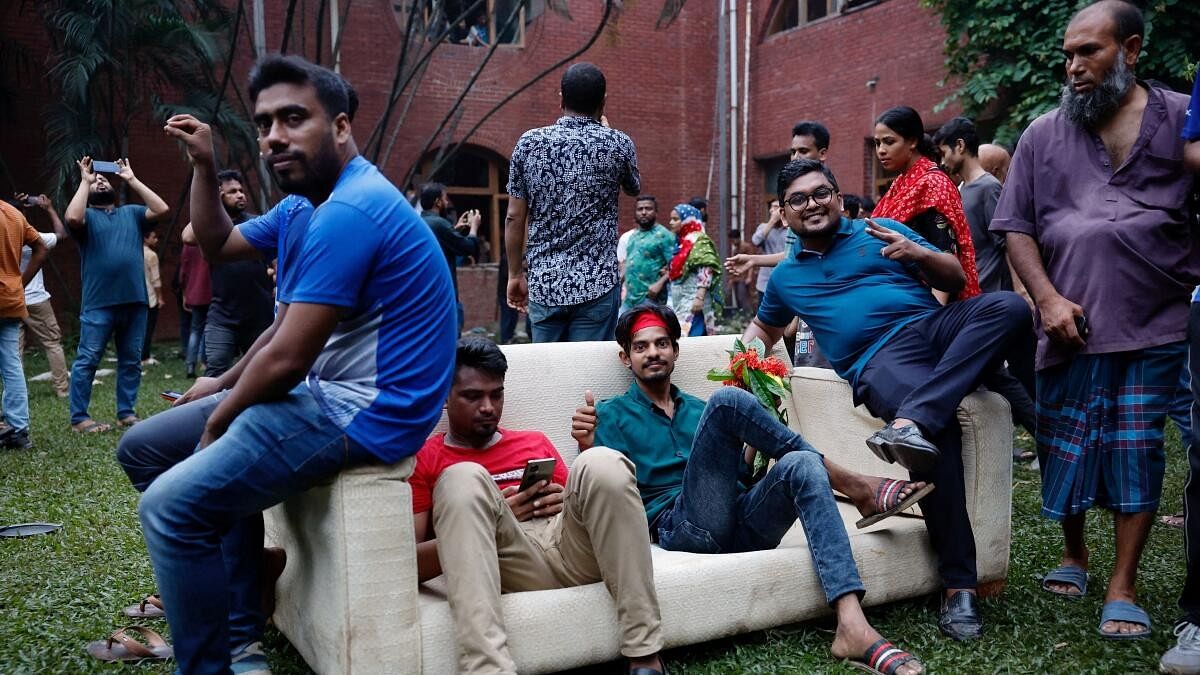
People enter the Ganabhaban, the Prime Minister's residence, in Dhaka
Credit: Reuters Photo
An agitation that started in Bangladesh with a demand to end the quota system reserving 30 per cent of government jobs for families of veterans who fought in Bangladesh's war of independence in 1971 intensified on Monday forcing the ouster of Awami League. Sheikh Hasina resigned as the PM and without a concluding speech, abandoned her palace and fled the country as protesters stormed her residence in Dhaka.
This is not the first time that the residence of a prominent politician was stormed. The world had been a witness to such instances in the past. Agitations against political leaders like Gotabaya Rajapaksa and Muammar Muhammad Abu Minyar al-Gaddafi had turned violent and gruesome.
Let us take a look at politicians/prominent faces worldwide whose residences were stormed:
Gotabaya Rajapaksa (former Sri Lanka President)
It was in July 2022 when protesters in Sri Lanka, enraged over the country's worsening economic crisis, stormed Rajapaksa's official residence in Colombo. Before the protesters reached his palace, Rajapaksa was taken to safety from where he is said to have fled to Maldives.
Former Sri Lankan president Gotabaya Rajapaksa.
Credit: X/@GotabayaR
Tearing down the security arrangements by police, the agitating people in Colombo were seen barging into the kitchen of the President's residence while a few others were seen taking a dip in the swimming pool.
Ranil Wickremesinghe (Sri Lankan President)
Sri Lankan President Ranil Wickremesinghe.
Credit: Reuters File Photo
Agitated protesters in the same month of 2022 entered the private residence of President Ranil Wickremesinghe and set it on fire. The Lankan police had later arrested three people for setting Wickremesinghe’s private residence on fire, which caused extensive destruction of the property. The presidential elections will be held in Sri Lanka on September 21, 2024.
Storming of Iraqi Parliament, attack on residence of Mustafa al-Kadhimi (former Prime Minister of Iraq)
July 2022 also witnessed mass protests in Iraq where agitators stormed the Iraqi Parliament to protest against the government formation efforts. The protesters were followers of an influential cleric Shiite Muqtada al-Sadr. The protesters breached the high-security Green Zone in Baghdad, opposing the nomination of a pro-Iran rival candidate for Prime Minister.
Former Iraqi Prime Minister Mustafa al-Kadhimi.
Credit: Reuters Photo
Sadr's block had won most seats in the elections, but wasn't in power due to a political deadlock. Months ago in November 2021, an explosives-laden drone had attacked the residence of Prime Minister Mustafa al-Kadhimi in Baghdad. The Iraqi security officials had said it was an assassination attempt, marking an escalation of tensions between the country’s government and Iran-backed militia groups.
Viktor Yanukovych (former President of Ukraine)
In February 2014, Ukrainian President Yanukovych fled Kyiv after protesters turned violent. The parliament had passed a resolution that year which said Yanukovych "is removing himself from power because he is not fulfilling his obligations".
Viktor Yanukovych.
Credit: encyclopediaofukraine.com
The protests went on for three months before Yanukovych fled Ukraine and agitators took full control of the country. They were also protesting against the signing of an European Union-sponsored peace deal. The agitated people took over Yanukovych's palace and also barged into his former residence.
Muammar Gaddafi (Libyan dictator)
The four-decade long rule of Libyan leader Muammar Gaddafi ended in October 2011 after he was killed in thrashing by protesters. Several Libyans had taken to streets protesting against the alleged 42-year 'dictatorship' of Gaddafi who had sworn to chase down the “cockroaches” and “rats” who had taken up arms against him “inch by inch, room by room, home by home, alleyway by alleyway, person by person", as per the UN Human Rights Watch.
One of the powerful Libyan dictators, Muammar Gaddafi, was hunted and summarily killed by insurgents in 2011 after being toppled in a NATO-backed uprising.
Credit: X/@Egideevan1
While pro-Gaddafi forces detained several protesting against their leader, the eight-month long conflict ended with the intervention of NATO in which Gaddafi and his acquaintances found themselves cornered in Sirte, the leaders' hometown where he tried fleeing. Protests by anti-Gaddafi individuals intensified and the leader fled in a convoy which came under attack by a NATO fired missile. Gaddafi abandoned the convoy and rushed to a villa where Misrata militias caught him.
The Libyan leader succumbed to intense kicks and blows by the militia groups. He died before being taken to the hospital.